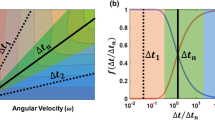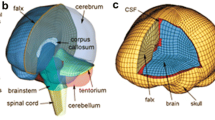Abstract
Brain injury research in sport employs a variety of physical models equipped with accelerometers. These acceleration signals are commonly processed using filters. The purpose of this research was to determine the effect of applying filters with different cutoff frequencies to the acceleration signals used as input for finite element modeling of the brain. Signals were generated from reconstructions of concussion events from American football and ice hockey in the laboratory using a Hybrid III headform. The resulting acceleration signals were used as input for the University College Dublin Brain Trauma Model after being processed with filters. The results indicated that using a filter with a cutoff of 300 Hz or higher had little effect on the resulting strain measures. In some cases there was some effect of the filters on the peak linear (8–30g) and rotational measures (1000–4000 rad/s2), but little effect on the finite element strain result (approximately 2–6 %). The short duration and high magnitude accelerations, such as the puck impact, were most affected by the cutoff frequency of different filters.


Similar content being viewed by others
References
Zhang L, Yang KH, King AI (2004) A proposed injury threshold for mild traumatic brain injury. J Biomech Eng 126:226–236
Cournoyer J, Post A, Rousseau P, Koncan D, Hoshizaki TB (2014) A comparison of brain deformation for head impact resulting in persistent post-concussive syndrome and concussion for elite hockey players. In: proceedings of The Sport Concussion Conference, Chicago, IL, July 11–13
Oeur RA, Karton C, Post A, Rousseau P, Hoshizaki TB, Marshall S, Brien S, Smith A, Cusimano MD, Gilchrist MD (2015) A comparison of the head dynamic response and brain tissue deformation from impacts resulting in concussion, concussion with persistent post-concussive symptoms, and subdural hematoma. J Neurosurg 123(2):415–422. doi:10.3171/2014.10.JNS14440
Post A, Hoshizaki TB, Gilchrist MD, Brien S, Cusimano MD, Marshall S (2015) Traumatic brain injuries: the influence of the direction of impact. Neurosurg 76(1):81–91
Beckwith JG, Chu JJ, Greenwald RM (2007) Validation of noninvasive system for measuring head acceleration for use during boxing competition. J App Biomech 23(3):238–244
Crisco JJ, Fiore R, Beckwith JG, Chu JJ, Brolinson PG, Duma S, McAllister TW, Duhaime AC, Greenwald RM (2010) Frequency and location of head impact exposures in individual collegiate football players. J Ath Train 45(6):549–559
Pellman EJ, Viano DC, Tucker AM, Casson IR (2003) Concussion in professional football: location and direction of helmet impacts—Part 2. Neurosurg 53(6):1328–1341
Aare M, Halldin P (2003) A new laboratory rig for evaluating helmets subject to oblique impacts. Traffic Inj Prev 4(3):240–248
Kendall M, Walsh ES, Hoshizaki TB (2012) Comparison between Hybrid III and Hodgson-WSU headforms by linear and angular dynamic impact response. J Sport Eng Tech 226(3–4):260–265
Post A, Oeur A, Hoshizaki TB, Gilchrist MD (2011) Examination of the relationship of peak linear and angular acceleration to brain deformation metrics in hockey helmet impacts. Comput Meth Biomech Biomed Eng 16(5):511–519
Crisco JJ, Wilcox BJ, Machan JT, McAllister TW, Duhaime A, Duma SM, Rowson S, Beckwith JG, Chu JJ, Greenwald RM (2012) Magnitude of head impact exposures in individual collegiate football players. J App Biomech 28:174–183
Allison MA, Kang YS, Bolte JH IV, Maltese MR, Arbogast KB (2014) Validation of a helmet-based system to measure head impact biomechanics in ice hockey. Med Sci Sport Exer 46(1):115–123
Karton C, Hoshizaki TB, Gilchrist MD (2013) The influence of inbound mass on the dynamic impact response of the Hybrid III headform and tissue deformation response characteristics. J ASTM Int. doi:10.1520/STP155220120175
Newman JA, Beusenberg MC, Shewchenko N, Withnall C, Fournier E (2005) Verification of biomechanical methods employed in a comprehensive study of mild traumatic brain injury and the effectiveness of American football helmets. J Biomech 38:1469–1481
King AI, Yang KH, Zhang L, Hardy W, Viano DC (2003) Is head injury caused by linear or rotational acceleration. In: Proceedings of IRCOBI conference, Lisbon, Portugal
Forero Rueda MA, Cui L, Gilchrist MD (2011) Finite element modelling of equestrian helmet impacts exposes the need to address rotational kinematics in future helmet designs. Comput Meth Biomech Biomed Eng 14:1021–1031
Post A, Hoshizaki TB (2015) Rotational acceleration, brain tissue strain, and the relationship to concussion. J Biomech Eng 137(3). doi:10.1115/1.4028983
Yogandandan N, Li J, Zhang J, Pintar FA, Gennarelli TA (2008) Influence of rotational acceleration-deceleration pulse shapes on regional brain strains. J Biomech 41:2253–2262
Post A, Hoshizaki TB, Gilchrist MD (2012) Finite element analysis of the effect of loading curve shape on brain injury predictors. J Biomech 45:679–683
Hutchison MH (2011) Concussion in the National Hockey League (NHL): The video analysis project. PhD Thesis, University of Toronto, Toronto, Canada
Rousseau P (2014) An analysis of dynamic concussion metrics associated with elite ice hockey elbow-to-head and shoulder-to-head collisions. PhD Thesis, University of Ottawa, Ontario, Canada
Post A, Karton C, Hoshizaki TB, Gilchrist MD (2014) Analysis of the protective capacity of ice hockey helmets in a concussion injury reconstruction. In: Proceedings IRCOBI, Berlin, Germany, 12–14 September
Rousseau P, Hoshizaki TB (2015) Defining the effective impact mass of elbow and shoulder strikes in ice hockey. Sport Biomech 14(1):57–67. doi:10.1080/14763141.2015.1025236
Padgaonkar AJ, Kreiger KW, King AI (1975) Measurement of angular acceleration of a rigid body using linear accelerometers. J Appl Mech 42:552–556
Walsh ES, Hoshizaki TB (2012) Comparative analysis of the Hybrid III neckform to unbiased neckforms using a centric and non-centric impact protocol. Presentation at the ASTM Symposium on the mechanism of concussion in sports, Atlanta, GA, 13 November
Horgan TJ, Gilchrist MD (2003) The creation of three-dimensional finite element models for simulating head impact biomechanics. IJCRASH 4:353–366
Horgan TJ, Gilchrist MD (2004) Influence of FE model variability in predicting brain motion and intracranial pressure changes in head impact simulations. IJCRASH 9(4):401–418
Post A, Kendall M, Koncan D, Cournoyer J, Hoshizaki TB, Gilchrist MD, Brien S, Cusimano MD, Marshall S (2015) Characterization of persistent concussive syndrome through injury reconstruction and finite element modelling. J Mech Behav Biomed Mat 41:325–335
Nahum AM, Smith R, Ward C (1977) Intracranial pressure dynamics during head impact. In: Proceedings of 21st Stapp Car Crash Conference, Warrendale, PA: 337
Hardy WN, Foster CD, Mason MJ, Yang KH, King AI, Tashman S (2001) Investigation of head injury mechanisms using neutral density technology and high-speed biplanar X-ray. Stapp Car Crash J 45:337–368
Doorly MC, Gilchrist MD (2006) The use of accident reconstruction for the analysis of traumatic brain injury due to head impacts arising from falls. Comput Meth Biomech Biomed Eng 9(6):371–377
Ruan JS (1994) Impact biomechanics of head injury by mathematical modeling. PhD thesis, Wayne State University, Michigan, USA
Zhou C, Khalil TB, King AI (1995) A new model for comparing responses of the homogeneous and inhomogeneous human brain. In: Proceedings of the 39th Stapp Car Crash Conference 121–136
Willinger R, Taled L, Pradoura P (1995) Head biomechanics from finite element model to the physical model. In: Proceedings of the IRCOBI Conference
Zhang L, Yang KH, King AI (2001) Comparison of brain responses between frontal and lateral impacts by finite element modeling. J Neurotrauma 18(1):21–31
Kleiven S, Von Holst H (2002) Consequences of size following trauma to the human head. J Biomech 35:135–160
Mendis KK, Stalnaker RL, Advani SH (1995) A constitutive relationship for large deformation finite element modeling of brain tissue. ASME J Biomed Eng 117:279–285
Miller K, Chinzei K (1997) Constitutive modelling of brain tissue: experiment and theory. J Biomech 30(11):1115–1121
Miller R, Margulies SS, Leoni M, Nonaka M, Chen X, Smith D, Meaney DF (1998) Finite element modeling approaches for predicting injury in an experimental model of severe diffuse axonal injury. In: Proceedings of 42nd Stapp Car Crash Conference, Arizona, 155–166
Author information
Authors and Affiliations
Corresponding author
Ethics declarations
Disclosure of funding
This research was not supported by any research grant.
Conflict of interest
The authors do not have any conflict of interests involved with this research.
Rights and permissions
About this article
Cite this article
Post, A., Clark, J.M., Robertson, D.G.E. et al. The effect of acceleration signal processing for head impact numeric simulations. Sports Eng 20, 111–119 (2017). https://doi.org/10.1007/s12283-016-0219-5
Published:
Issue Date:
DOI: https://doi.org/10.1007/s12283-016-0219-5




